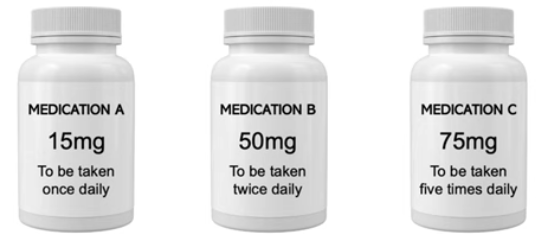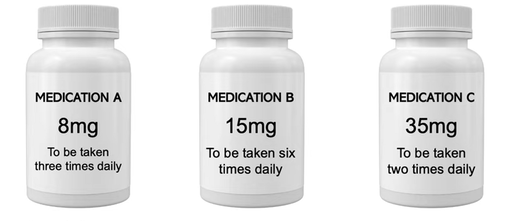Numeracy for health is a matter of life and death
The charity National Numeracy says "Unlike calculating money, or counting eggs in a cake, using numbers in health can be fundamental to our very survival"
National Numeracy has argued that improving numeracy skills in the UK is critical for ensuring that patients are safe to self-manage their care, protect themselves from future illness, and make good choices about their treatments in the NHS. Evidence repeatedly points to numeracy as a key indicator for patients’ abilities to manage their diabetes care, take screening tests, and live healthily. Despite these benefits, the Skills for Life Survey found that 49% of the population is working at or below the level expected of a child at primary school. Further research has found that 61% of the UK population does not have the numeracy-specific skills needed to maintain their health (Rowlands et al.).
Many healthcare calculations require Level 2 functional numeracy skills (roughly equivalent to GCSE A*-C). However, the Skills for Life Survey showed that in 2011, only 21.8% of the population in the UK had numeracy skills to this level.
It is difficult to monitor your weight, understand nutritional labels, or count how many units of alcohol you drink a week without good numeracy skills. There is evidence finding that people with lower numeracy levels are less likely to take screening tests, detecting early signs of fatal diseases. Cancer Research UK found that poor numeracy levels affect people’s decision to take a bowel cancer screening test, independent of their socioeconomic background.
Empowering patients with choice in the NHS is only possible if patients are simultaneously empowered with the numeracy skills needed to make healthcare decisions.
A 30-year-old man is told the Green Zone (the OK zone) is a reading between 80% and 100% of your best reading and the Worry Zone is between 50% and 80% of your best reading. His best reading is 400 L/min but he cannot work out the point that he needs to seek medical help. Apter et al. (2006, 2008).
Diabetes calculations requiring Functional Skills Maths Level 2:
Calculating carbohydrate content in food: Total weight of food (g)/100 X Carbohydrate content of food per 100g = carbohydrate content (g)
Public health bodies must acknowledge growing evidence that improving numeracy is a significant part of improving people’s health and wellbeing, says National Numeracy.
Numeracy levels have been found to be insufficient amongst NHS doctors, especially amongst those who are newly qualified or working in the community (Wheeler et al.).
Studies from twenty years ago found that only 12.7% of doctors could answer a group of five numeracy questions calculating drug doses correctly (Rolfe & Harper). Nurses have similar issues with numeracy (McMullan et al., Jukes & Gilchrist). A study found that only 55% of the Registered Nurses could score over 80% of questions correctly on calculations for oral medication and injections.
The importance of numeracy is reinforced by evidence revealing that many doctors and nurses in the NHS do not have adequate numeracy levels to consistently complete the calculations they must carry out on a day to day basis (Rolfe & Harper, Wheeler et al., McMullan et al., Jukes & Gilchrist). Evidence suggests that medical error results in 755,000 more patients being admitted to hospital each year, costing the NHS £2.5bn per annum (Frontier Economics). Improving and maintaining healthcare workers’ numeracy could therefore contribute significantly to reducing this level of medical error, and improving efficiency in the NHS.
ref National Numeracy
Q1 A patient's body temperature was 36.5 degrees centigrade, but in the afternoon it was 38.3 degrees centigrade. How many degrees higher was the patient's temperature in the afternoon?
Q2 After year's of drinking in secret, Jake has decided to face his alcohol misuse problem. His doctor prescribed a drug to ease his withdrawal symptoms, with the following instructions: day 1: 30mg four times a day; day 2: 25mg four times a day; day 3: 20mg four times a day; day 4: 15mg four times a day; days 5 & 6: 10mg four times a day; days 7,8, & 9: 5 mg four times a day. Assuming Jake followed the instructions, how much of the drug did he consume in total?
Ref for Q1 & Q2
Q3: If you had 2498 patients who had undergone day surgery, 67 patients who were admitted with a surgical emergency and 278 patients admitted for planned complex surgery how many patients in total would have undergone surgery?
Q4: 7.5 mg of Enalapril is prescribed and the dose in each tablet is 1.25 mg. How many tablets should be given?
Q5: 0.06 X 1300 = ?
Ref for Q 3, 4, & 5
Q6 A person is prescribed Ropinirole 1.5 mg divided into three doses. How many micrograms is each dose?
Choose one answer from the following:
Ref: Q6
Q7: Referring to the image below, how many milligrammes in total will the patient take in 10 days?
National Numeracy has argued that improving numeracy skills in the UK is critical for ensuring that patients are safe to self-manage their care, protect themselves from future illness, and make good choices about their treatments in the NHS. Evidence repeatedly points to numeracy as a key indicator for patients’ abilities to manage their diabetes care, take screening tests, and live healthily. Despite these benefits, the Skills for Life Survey found that 49% of the population is working at or below the level expected of a child at primary school. Further research has found that 61% of the UK population does not have the numeracy-specific skills needed to maintain their health (Rowlands et al.).
Many healthcare calculations require Level 2 functional numeracy skills (roughly equivalent to GCSE A*-C). However, the Skills for Life Survey showed that in 2011, only 21.8% of the population in the UK had numeracy skills to this level.
It is difficult to monitor your weight, understand nutritional labels, or count how many units of alcohol you drink a week without good numeracy skills. There is evidence finding that people with lower numeracy levels are less likely to take screening tests, detecting early signs of fatal diseases. Cancer Research UK found that poor numeracy levels affect people’s decision to take a bowel cancer screening test, independent of their socioeconomic background.
Empowering patients with choice in the NHS is only possible if patients are simultaneously empowered with the numeracy skills needed to make healthcare decisions.
A 30-year-old man is told the Green Zone (the OK zone) is a reading between 80% and 100% of your best reading and the Worry Zone is between 50% and 80% of your best reading. His best reading is 400 L/min but he cannot work out the point that he needs to seek medical help. Apter et al. (2006, 2008).
Diabetes calculations requiring Functional Skills Maths Level 2:
Calculating carbohydrate content in food: Total weight of food (g)/100 X Carbohydrate content of food per 100g = carbohydrate content (g)
Public health bodies must acknowledge growing evidence that improving numeracy is a significant part of improving people’s health and wellbeing, says National Numeracy.
Numeracy levels have been found to be insufficient amongst NHS doctors, especially amongst those who are newly qualified or working in the community (Wheeler et al.).
Studies from twenty years ago found that only 12.7% of doctors could answer a group of five numeracy questions calculating drug doses correctly (Rolfe & Harper). Nurses have similar issues with numeracy (McMullan et al., Jukes & Gilchrist). A study found that only 55% of the Registered Nurses could score over 80% of questions correctly on calculations for oral medication and injections.
The importance of numeracy is reinforced by evidence revealing that many doctors and nurses in the NHS do not have adequate numeracy levels to consistently complete the calculations they must carry out on a day to day basis (Rolfe & Harper, Wheeler et al., McMullan et al., Jukes & Gilchrist). Evidence suggests that medical error results in 755,000 more patients being admitted to hospital each year, costing the NHS £2.5bn per annum (Frontier Economics). Improving and maintaining healthcare workers’ numeracy could therefore contribute significantly to reducing this level of medical error, and improving efficiency in the NHS.
ref National Numeracy
Q1 A patient's body temperature was 36.5 degrees centigrade, but in the afternoon it was 38.3 degrees centigrade. How many degrees higher was the patient's temperature in the afternoon?
Q2 After year's of drinking in secret, Jake has decided to face his alcohol misuse problem. His doctor prescribed a drug to ease his withdrawal symptoms, with the following instructions: day 1: 30mg four times a day; day 2: 25mg four times a day; day 3: 20mg four times a day; day 4: 15mg four times a day; days 5 & 6: 10mg four times a day; days 7,8, & 9: 5 mg four times a day. Assuming Jake followed the instructions, how much of the drug did he consume in total?
Ref for Q1 & Q2
Q3: If you had 2498 patients who had undergone day surgery, 67 patients who were admitted with a surgical emergency and 278 patients admitted for planned complex surgery how many patients in total would have undergone surgery?
Q4: 7.5 mg of Enalapril is prescribed and the dose in each tablet is 1.25 mg. How many tablets should be given?
Q5: 0.06 X 1300 = ?
Ref for Q 3, 4, & 5
Q6 A person is prescribed Ropinirole 1.5 mg divided into three doses. How many micrograms is each dose?
Choose one answer from the following:
- 5
- 50
- 0.5
- 500
Ref: Q6
Q7: Referring to the image below, how many milligrammes in total will the patient take in 10 days?
Q8: Referring to the image below, how many milligrammes in total will the patient take in 7 days?
Q9: Referring to the image above, "A patient has been prescribed 42mg of medication C over a 7 day period. How many tablets should they be administered in total?" This is how the question actually appeared, but it is confusing because it fails to say whether the 42mg is for 1 day or for 7 days. If read as stated, then it means just 3 tablets to last 7 days, which is nonsense, so the alternative is 42mg PER DAY. To answer the questions, I suggest you assume the questions says "42mg per day of medication C"
Q10: Using the data above, at what time does he arrive at the hospital?
Q11: Using the data above, at what time does Stacey arrive at the hospital?
Q12: Using the data above, will he be late for work?
Ref for Qs 7-12 inclusive is NHS Numeracy and Literacy Test Questions & Answers!
Ref for Qs 7-12 inclusive is NHS Numeracy and Literacy Test Questions & Answers!
Q13 What is wrong with the question above? (Ref)
|
|
Answer the questions above and state your answers in the Comments box opposite.
When you're ready, enter your name and email address, then press the Submit button to send your answers. Image credit: Wikipedia |







